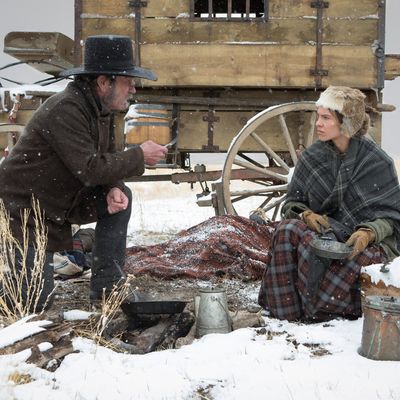
Tommy Lee Jones’s The Homesman is a halting, uncertain work by design. Set in the bleak, forbidding loneliness of the Nebraska territory in the 1850s, the film presents the absurdity of civilization in a blank, beautiful wasteland. As it opens, we see single farmer Mary Bee Cuddy (Hilary Swank) trying to plow her patch of dirt, the gates of her nondescript barn open so wide that the whole structure, like her very existence, seems like it could be swept away with a whisper. Later that night, she makes dinner and pie for a fellow farmer, trying to create a sense of home. She even sings a song for him, her fingers dancing over a cloth with a piano pattern design. There’s a reason for her actions: She’s looking to marry. But the man brusquely laughs the idea off, calling her bossy and plain — an insult that will be repeated later in the film. So much for the romance of pioneer life.
Cuddy is a member of a small community hurting after a rough winter. Battered by foul weather, disease, and death, three of the women have gone mad: One lost her mind at her mother’s loss, another killed her newborn after her livestock died, and yet another watched her three kids die of diphtheria in a matter of days. Someone needs to take the women back to Iowa and to civilization, a journey of at least five weeks through the vast prairie and across the Missouri River. The men draw lots to determine who will lead these women, and Cuddy joins in, taking the place of a particularly unreliable (male) farmer; when she winds up being the one selected, nobody else even blinks. Of course she’ll be the one to go — she has no attachments and pretty much nothing to live for. That’s not to say she isn’t scared. Right after she’s selected, we see her step out of the town’s tiny church and look out at the horizon in terror and awe.
So Cuddy enlists the aid of someone seemingly more experienced — a “claim-jumper” (that is to say, squatter) and former dragoon named George Briggs (Tommy Lee Jones), whom she saves from hanging. He’s reluctant, but she offers him $300. Their back-and-forth — she’s earnest and compassionate, he’s pragmatic and cynical — fuels much of the film. But director Jones shakes things up tonally. Right from the beginning, he cuts away to brief, sharp flashes from the lives of the three women, giving us stylized little glimpses of the terrors they’ve endured. When he cuts away to Briggs’s own outlaw narrative, we feel like we’ve suddenly, briefly stepped into a different, more boisterous film. At first it’s hard to tell if all this mismatch is intentional. Some of it probably comes from having to condense Glendon Swarthout’s novel, and one wonders if there’s been some heavy cutting involved, an impression furthered by the fact that the film is filled with fairly major actors in seemingly small parts.
But when these narratives converge and we start to follow Briggs and Cuddy’s journey with the women across the plains, the tonal unease continues in other ways. The episodic story proceeds in fits and starts. A scene where Cuddy separates from the others in order to repair and tidy the ruined grave of an anonymous 11-year-old girl, and then gets lost, is played like something out of a fever dream. At another point, Briggs dances a little jig out of the blue, and the moment has none of the rowdy tribal charm of, say, a John Ford movie; instead, it feels like the sudden rantings of a desperate lunatic. All these detours give us the distinct impression that we might be going a little mad ourselves.
Jones has made the Western his genre of choice in numerous films, including his previous feature directorial outing, 2005’s underrated The Three Burials of Melquiades Estrada. But The Homesman has almost none of the romance of the West. Instead, it portrays how civilization insinuates itself in sly little ways, a termite scratching into a seemingly impermeable wall of wilderness. Cuddy’s attempts to show compassion and care for her wards seem pointless at first, and Briggs’s resistance to her, while brusque, is inevitable. But later we see the effect it has on him. That shouldn’t come as a surprise to anybody; there’d be no movie if somebody didn’t change. Still, I was impressed with how Jones’s uncomfortable mixing of tones in the first half of the film gave way to something more elegiac and evocative by the end. For much of its running time, The Homesman doesn’t quite seem to know where it’s going. But once it actually gets there, it attains a hardscrabble nobility.





